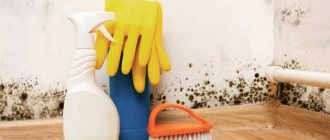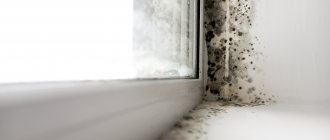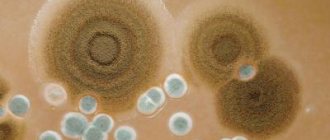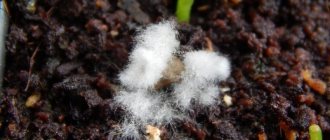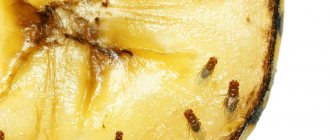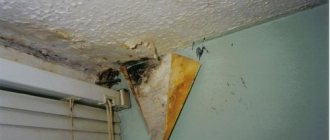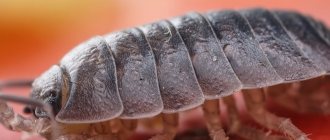Mold is not the most pleasant neighborhood. No one is safe from its appearance. It becomes a source of unpleasant odor, allergies and even some diseases. Today we will tell you the reasons for its occurrence, as well as effective methods to combat it.
Types of mold
Let's get straight to the point:
- Type of white mold
Many have seen her and know what she looks like. The soil in which houseplants are planted emits steam due to excess moisture. A white coating appears, which is mold. It is not dangerous for humans unless you have special sensitivity and allergies.
- Type of green mold
This type is observed on food remains that are in a confined space. For example in a container. It is also found on building bricks. Green mold that gets into the stomach causes various types of diseases and poisoning.
- Type of black mold
The most dangerous species. It appears on the walls, ceiling, flooring. Affects different types of surfaces. If you leave it and do nothing, you will have problems sleeping, mold will cause dizziness, asthma, headaches and even increase a person’s temperature. The most dangerous consequences are dermatitis, lung cancer, pneumonia and bronchitis.
- Type of blue mold
This type is noticed on a wooden surface. This could include parquet flooring, picture frames and furniture. It comes out from under the paint layer and looks like a dark bluish coating.
- Type of rotten mold
Also affects wooden surfaces. Her color palette is multifaceted. From gray to brown shades. The wood then cracks and becomes lighter.
No one is immune from mold. Finishing materials do not guarantee that you will never have one. Mold doesn't look good. In addition, it is dangerous to health, so as soon as you see its appearance, start exterminating it.
Prevention
It is worth taking care of protection against mold before it penetrates into the apartment. Residents of old panel and brick houses need to regularly carry out preventive measures.
These include:
- Frequent and sufficient ventilation of rooms.
- Thorough wet cleaning with special disinfectant solutions.
- Ensuring free air circulation through micro-ventilation and proper placement of furniture in the rooms.
- Cosmetic repairs at least once every five years.
- Timely contacting sanitary services to treat attics, basements and entrances.
- Regular cleaning of the apartment, selection of high-quality detergents and household appliances.
Why does mold appear?
To defeat mold, it is necessary to determine the cause of its appearance. After all, its spores are found in any room, and if favorable conditions are created for it, it begins to come to life and grow.
So let's get down to business.
- High humidity combined with poor ventilation. Kitchens and bathrooms are often affected areas, for obvious reasons.
- Walls that are frozen.
- Leaking water from water pipes
- Ground moisture
- Leaky roof in a house
- A room that is rarely heated
When mold appears, a “dirty” heavy aroma appears that is familiar to everyone. It is important not only to get rid of such plaque, but also to prevent the cause of its appearance.
Reasons for appearing in the house
Fungal growth on the wall
Surfaces in a house or apartment can become moldy for various reasons:
- High air humidity, over 70%. Most often on loggias, balconies and bathrooms, where the fungus starts in the first place
- Insufficient insulation of walls, due to which they freeze in winter, and then thaw and become damp, creating an ideal microflora for the development of spores
- Improper insulation of the subfloor (especially in private homes). That is why it is recommended to make a screed and a “warm floor” to forget about dampness and mold
Spores can enter an apartment through water, air, people or animals. If the microflora is unfavorable for their development, then the walls will not bloom. But if the house is humid and damp, then the fungus will definitely find a secluded place in a corner or on the ceiling and begin to develop intensively.
In winter, when the glass sweats, condensation drains from it and moisture collects on the windowsill below, which often causes mold to appear.
They love plaster, wallpaper, tiles, stone, and grow on tile joints
The main signs are the formation of black and gray spots. The smell of mold is damp, reminiscent of amber from cellars.
It is important to determine the cause and remove it , otherwise the fight against fungal organisms will be ineffective.
Antiseptic primer for mold control
This product is sold in the store and is represented by a wide range of products. All you have to do is choose. It fights mold perfectly and is the most effective remedy in the war against it. Simply apply it to a surface cleaned of fungus. An important nuance. There should not be a hint of mold on the infected surface, and for this it must be thoroughly cleaned. Even if it penetrated into the deep layers of finishing. After processing, proceed to further surface finishing.
Fungus on the ground. What are the reasons and how to get rid of it?
Sometimes you can notice a white coating in flower pots, which can be caused by either hard water or fungal microflora. Mold in flower pots is distinguished from ordinary mold by its “fluffy” surface. Fungus in them is a fairly common phenomenon, which in most cases is explained by excessive watering of plants, especially in early spring or late autumn, when water slowly evaporates from the soil due to low temperatures. If, in addition, little sunlight gets into the apartment, it is warm and there is poor ventilation, then completely comfortable conditions for mold are created. Sometimes you can get rid of it by replacing the affected layer with new soil and changing the tactics of watering the flowers, as well as providing access to sunlight and good ventilation. If a plant variety requires abundant watering, it is necessary to regularly loosen the soil, and not just the top layer. This must be done deeply, but carefully, so as not to accidentally damage the roots.
Sometimes mold fungi appear on the ground not from excessive watering; they can also be in purchased soil. The fungus primarily affects young plants and seedlings, which can die from mold spores. In addition, mold fungi can infect the entire soil in a flower pot, even if watering is not excessive. In this case, replanting and complete removal of the contaminated soil cannot be avoided. Also, the appearance of mold on the stem or soil can be caused by watering the plant with cold water, an insufficiently heated room in which it grows, poor drainage or poor-quality soil.
Most often, drying the soil does not help solve the fungus problem, and with each new watering of the plant the problem gets worse. In this case, it is necessary to remove all mold and sprinkle the ground with crushed activated carbon. You can also treat it with an antifungal agent, such as Fungicide. This procedure can prevent plant rotting and mold growth. After this, do not forget to periodically loosen the soil and add new soil on top. Subsequently, it is better to think about completely changing the soil, as well as washing the flower pot using laundry soap and a brush.
In no case should we forget about preventing the reappearance of white mold on the ground. Follow these simple rules to help get rid of fungus forever:
- loosen the soil regularly - this will ensure effective aeration and active oxygen supply;
- install drainage in the pot according to the rules;
- excess water must be able to evaporate; for this, the flower pot must have holes of the required diameter;
- periodically add crushed activated carbon or wood ash to the soil, which gives an antiseptic effect and improves soil ventilation;
- If the problem affects greenhouse plants or seedlings, you need to take care of more frequent ventilation of the greenhouse and sufficient illumination of the seedlings with sunlight.
Bleach for mold control
Excellent against fungus on smooth surfaces. Wood, gypsum board and other porous surfaces should not be treated with this product. It's simply not effective. Also pay attention to the fact that bleach eats not only the fungus, but also the color of the finish, as well as its structure.
Wear gloves when treating surfaces with bleach. Otherwise, this product will also “eat” your hands. Dilute it with water in proportions of 1/10. After that, simply apply it to the prepared and mold-free surface.
Preventive measures to prevent fungal manifestations
Regularly performing a number of actions will help you avoid the procedures that are performed to get rid of black mold on walls and other areas. This:
- ensuring adequate ventilation of premises;
- elimination of sources that distribute moisture;
- Carrying out high-quality insulation and waterproofing work in houses and apartments.
Maintaining optimal air-thermal conditions will help prevent mold in the premises. The most common methods for removing them are presented above. With the help of industrial preparations and folk remedies, you can prevent the spread of black plaque on the walls in time.
Chemicals
- easy to use;
- long lasting effect;
- lack of chlorine in the composition;
- As a rule, they have a pleasant smell.
Common chemicals used to combat mold include fungicidal antiseptics
. Not only will they allow you to eliminate all traces of mold, but they will also help prevent its occurrence. When choosing them, you should pay attention to the purpose: often there are options intended solely for prevention - of course, in your case they will not provide any help.
Most popular options
- Mogel-Fri;
- Metas-Bio;
- Dali;
- Fongifluid;
- Neomid Bio;
- Olympus Stop mold.
How to use
- ventilate the room well before processing;
- cover the furniture and floor with film;
- put on gloves and a mask;
- prepare the wall for cleaning: remove the old finishing material, scrape off the top layer of mold deposits;
- treat the surface with a roller or brush, affecting not only the affected area, but also the entire area adjacent to them;
- let the antiseptic dry and then apply primer, putty, paint or wallpaper the problem area.
Methods for eliminating fungus
If the affected area is small, you can clean the mold off the walls yourself. There is no need to buy expensive detergents; you can remove mold with the products you have on hand.
Antiseptic primer
In particular, in old houses there are places on the walls where, with the advent of damp weather, mushrooms regularly appear. This is usually due to the fact that these areas are colder than surrounding areas, hence more water deposits on them.
